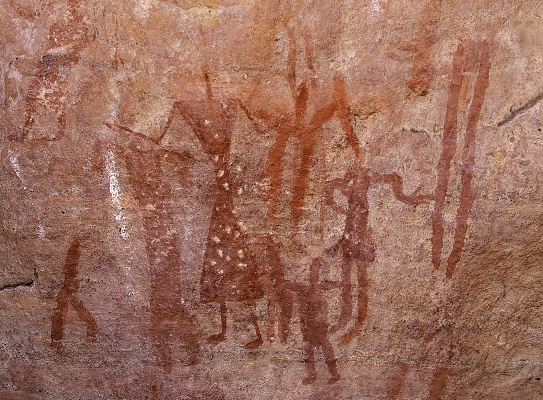Caballine (Horse) & Cameline paintings and petroglyphs

Acacus, Libya
The themes of this post-Neolithic rock art reflect the slow process of desertification which began in the Sahara from the 4th millennium BP. Large wild African fauna, except giraffe, disappeared and two new animal species became predominant; the horse and the dromedary.
Horses are depicted in a schematic, geometric style with human figures sometimes drawn as double triangles. Following, and partially overlapping with the Caballine (Horse) phase, the Cameline phase is characterized by images of dromedaries depicted in the schematic style or as pecked petroglyphs. This style is often associated with the Touareg people, whose writing, Tifinagh, is a component of this phase of drawings.
Caballine and Cameline rock art is found in many regions of the Sahara. Sometimes these paintings and/or petroglyphs are present in shelters adorned with Round Heads and/or Pastoral paintings. The difference between the various styles is usually very recognizable, mainly by the themes but also by the reduced dimensions of the figures and the very light shade of the red ochre. The post-Neolithic rock art has apparently nothing in common with the Round Head art, except the occasional placement in the same shelters.
Bibliography (selection):
Gauthier, Y. and Gauthier, C. (2008) Art rupestre, monuments funéraires et aires culturelles: nouveaux documents concernant le Messak, le sud-est du Fezzân et l’Oued Djerat. Les Cahiers de l’AARS 12: 89-104.
Gauthier, Y. and Gauthier, C. (2011) Des chars et des Tifinagh: étude aréale et corrélations. Les Cahiers de l’AAARS 15: 91-118.
Hachid, M. (2000) Les Premiers Berbères. Entre Méditerranée, Tassili et Nil (Alger/Aix-en-Provence:Ina-Yas,Edisud).
Barnett, T. and Mattingly, D. (2003) The Engraved Heritage: Rock-Art and Inscriptions. In D. Mattingly (ed.) The archaeology of Fazzan. Volume 1. Synthesis (Tripoli/London: The Department of Antiquities & The Society for Libyan Studies)279-316.